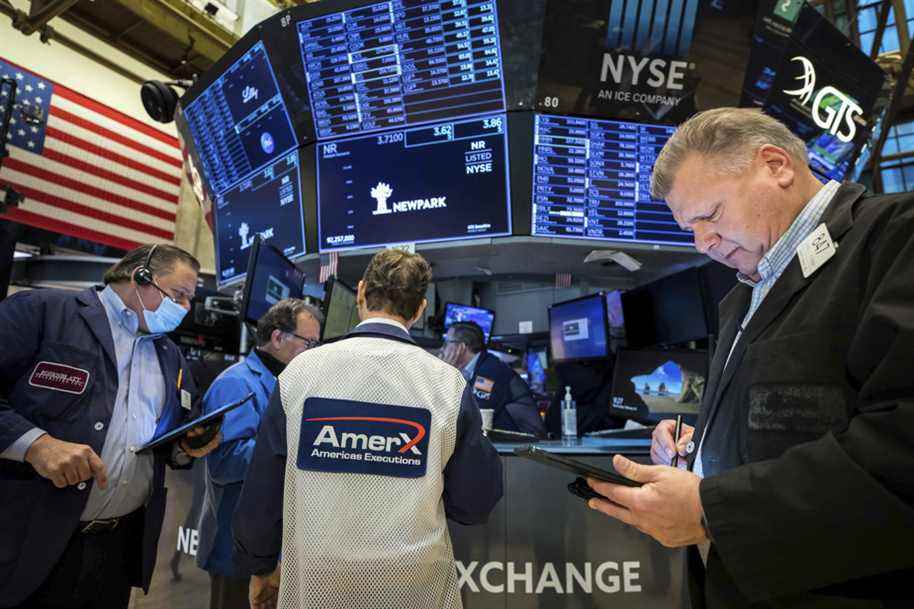(New York) The New York Stock Exchange ended in loss on Tuesday in the face of mounting tensions in Ukraine and after the announcement of US sanctions against Russia.
Updated yesterday at 4:56 p.m.
According to final results at the close, the Dow Jones index dropped 1.42% to 33,596.61 points. The tech-heavy NASDAQ fell 1.23% to 13,381.52 points. The S&P 500 fell 1.01% to 4304.76 points.
Earlier in the day the indexes gave way to more pessimism, dropping 2%, while overnight Russian President Vladimir Putin approved the sending of troops to eastern Ukraine to support the independence demands of two rebellious regions.
During an intervention at the White House, US President Joe Biden reacted by promising to impose sanctions against banks and “Russian elites”.
Russia, therefore, “can no longer raise money in the west and can no longer trade its new debt in our markets or in European markets”, said Joe Biden.
Faced with these announcements, Wall Street tempered its losses at the end of the session, judging that the American Administration did not play “the worst-case scenario” and retained some leeway, estimated Art Hogan of National Securities.
“The sanctions have been deployed in a reasonable way, the administration retains control to come back with more sanctions if necessary,” said the analyst.
Neither the Russian President himself – Vladimir Putin – nor Russia’s participation in the system of international financial transactions (which would affect oil exports) were targeted by the sanctions.
“You have to keep something in your pocket as a deterrent. That’s what the government did and the market is happy that it doesn’t have to factor the worst-case scenario into its prices,” Hogan concluded.
The price of oil ended up sharply, however moving away from the symbolic bar of 100 dollars a barrel, brushed against in the morning for Brent.
“Tensions between Russia and Ukraine pose a low risk to US corporate earnings,” JP Morgan analysts said in a note on Tuesday.
“But it’s the energy price shock, amid the central bank’s (Fed) monetary policy shift towards inflation-fighting, that could further weigh on investor sentiment and the outlook. growth,” they warned.
Yields on US 10-year debt remained stable around 1.93%.
The Case-Shiller index of US house prices released Tuesday was up 18.8% year on year in December, more than expected, a new element from fueling inflation, noted analysts at Schwab.
Consumer confidence in the United States also fell slightly in February, for the second month in a row, according to the Conference Board index released on Tuesday.
The eleven sectors of the S&P 500 ended in the red, weighted by consumer products (-3.04%).
The DIY chain Home Depot was sanctioned (-8.85% to 316.17 dollars), after warning that 2022 would see a deceleration in its growth. The group has however announced record turnover and a sharp increase in the dividend for 2021.
The department store chain Macy’s, which nevertheless surprised positively with a jump in sales of 28% over the past quarter, saw its title drop by 4.98%, to 24.42 dollars.
Shares of automakers fell as the sector worries about new problems in the supply chain that the escalating crisis in Ukraine may cause. Ford lost 4.16%, GM 3.77% and Tesla slipped 4.14% to $821.53.
Rising commodity prices limited Toronto Stock Exchange losses
The rise in commodity prices partially limited the losses of the Toronto Stock Exchange on Tuesday.
The Toronto floor’s S&P/TSX Composite Index lost 100.38 points to end the session with 20,907.82 points.
In the currency market, the Canadian dollar traded at an average rate of 78.47 cents US, down from 78.53 cents US on Friday.
On the New York Commodities Exchange, crude oil prices rose US$1.70 to US$91.91 a barrel, while natural gas rose 8.4 cents to US$4.46. million BTUs.
The price of gold advanced US$7.60 to US$1,907.40 an ounce and that of copper fell nearly 1 US cent to US$4.51 a pound.
The Canadian Press
